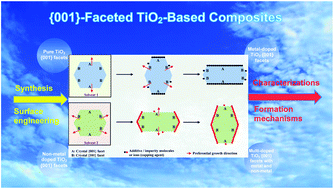Highly reactive {001} facets of TiO2-based composites: synthesis, formation mechanism and characterization
Abstract
Titanium dioxide (TiO2) is one of the most widely investigated metal oxides due to its extraordinary surface, electronic and catalytic properties. However, the large band gap of TiO2 and massive recombination of photogenerated electron–hole pairs limit its photocatalytic and photovoltaic efficiency. Therefore, increasing research attention is now being directed towards engineering the surface structure of TiO2 at the most fundamental and atomic level namely morphological control of {001} facets in the range of microscale and nanoscale to fine-tune its physicochemical properties, which could ultimately lead to the optimization of its selectivity and reactivity. The synthesis of {001}-faceted TiO2 is currently one of the most active interdisciplinary research areas and demonstrations of catalytic enhancement are abundant. Modifications such as metal and non-metal doping have also been extensively studied to extend its band gap to the visible light region. This steady progress has demonstrated that TiO2-based composites with {001} facets are playing and will continue to play an indispensable role in the environmental remediation and in the search for clean and renewable energy technologies. This review encompasses the state-of-the-art research activities and latest advancements in the design of highly reactive {001} facet-dominated TiO2via various strategies, including hydrothermal/solvothermal, high temperature gas phase reactions and non-hydrolytic alcoholysis methods. The stabilization of {001} facets using fluorine-containing species and fluorine-free capping agents is also critically discussed in this review. To overcome the large band gap of TiO2 and rapid recombination of photogenerated charge carriers, modifications are carried out to manipulate its electronic band structure, including transition metal doping, noble metal doping, non-metal doping and incorporating graphene as a two-dimensional (2D) catalyst support. The advancements made in these aspects are thoroughly examined, with additional insights related to the charge transfer events for each strategy of the modified-TiO2 composites. Finally, we offer a summary and some invigorating perspectives on the major challenges and new research directions for future exploitation in this emerging frontier, which we hope will advance us to rationally harness the outstanding structural and electronic properties of {001} facets for various environmental and energy-related applications.


 Please wait while we load your content...
Please wait while we load your content...